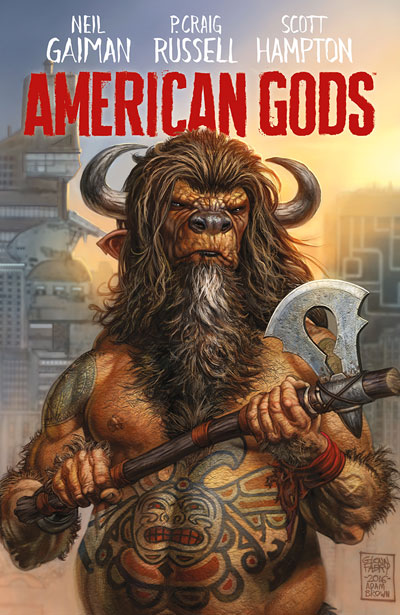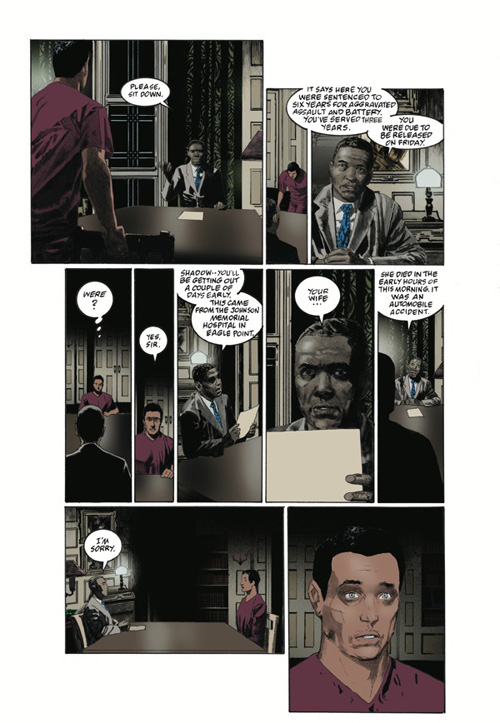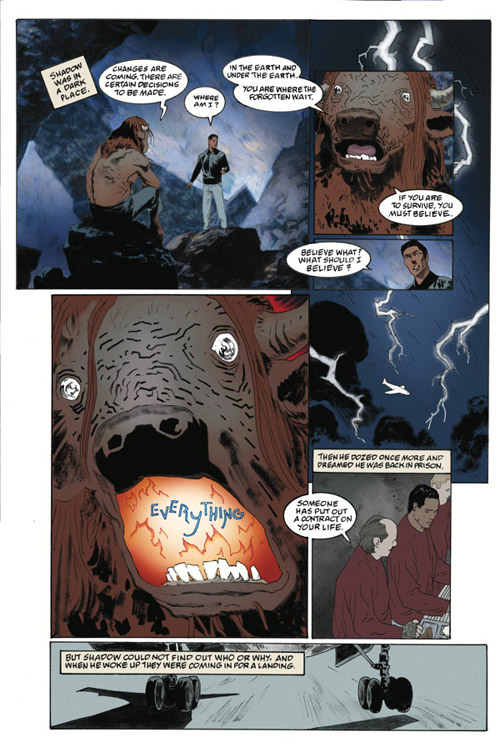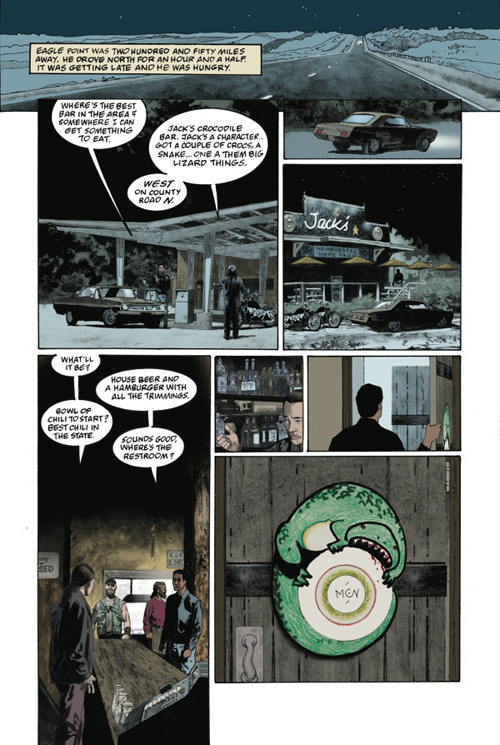A New Altar For American Gods
Jan 22, 2017
 |
by Vince Brusio
Imagine you have 20/20 vision, but then you have to instead focus on what’s under the carpet, or the back of the garage. You must see beyond sight. You must adopt a different perspective. This was P. Craig Russell’s job, in a sense, in adapting Neil Gaiman’s Nebula award–winning novel into American Gods: Shadows. To take American Gods and turn it into a comic adaptation, P. Craig Russell had to tailor and trim scenes, scenarios, and situations. And words. Neil Gaiman’s words. In this PREVIEWSworld Exclusive interview with P. Craig Russell, we get an inside glimpse into the deconstruction of the book's details, as well as the nourishment of nuance. This new series from Dark Horse Comics is going to be a monster, and we talk to the guy whose job it is to show the beast to high society because, after all, it’s going to be on television.
American Gods: Shadows #1 (JAN170096) is in comic shops March 15.
**********
Vince Brusio: So, you’re working on a comic book series with Neil Gaiman that’s soon a Starz television series. No pressure, right? Could the stakes be any higher? How do you wrap your head around such a big project? What does this gig mean to you as a creator? What’s going through your head while you’re working on American Gods: Shadows #1 (JAN170096)?
P. Craig Russell: One of the greatest challenges with adapting a 500-plus page novel is in keeping an awareness of the novel as a whole while breaking it down into 27 discreet parts, 27 being the number of issues its being serialized in. With approximately one page of the book to one page of graphic novel there’s a tremendous amount of winnowing down. I’m always questioning whether something I delete isn’t going to be something that pays off much later in the book and I've contacted Neil once already about a particular scene. (“You can drop it”). As a 598 page graphic novel it is a huge project but in a sense no different from approaching an eight page story. It just takes longer. Like any story you just start chipping away at it, approaching a scene from this way and that until something comes into focus and you build on that. It’s very much puzzle solving, finding a visual structure for pure prose, but it’s my favorite part of the process.
Vince Brusio: For the reader who’s new to American Gods, how can you best summarize Neil Gaiman’s vision? And what do you bring to Neil’s landscape?
P. Craig Russell: I don’t know that I can summarize Neil’s vision but I can say I admire the freshness of his vision, the wide open enjoyment (and bemusement?) of all the strange byways and backroads of America as seen through the eyes of a newly arrived Englishman. His intent seems to have been to see behind the curtain, or under the carpet, or back of the garage, and he takes great delight in it. Interesting that as Neil came to America his first novel was about all the strange people, characters, and Gods who also came to America. He imagined them as perhaps only a newcomer could.
Vince Brusio: So how does American Gods in comic format differ from the novel? What’s different? What’s the same?
P. Craig Russell: It differs from the novel only insofar as the art form of the graphic novel differs from a novel, or a play, or a short story. It tells the story with pictures, primarily, though not as purely as, say, a silent film. I make ample use of Neil’s prose. In fact the most difficult part is leaving so many choice bits behind. There’s a great deal of low key humor in the book which can easily be lost if focused too closely on the narrative drive. Though I know I can’t retain it all I am constantly aware of it and make sure to include as much as I can. Sometimes it’s those narrative tangents that give the book its own peculiar flavor. Lose those and you lose much of what makes the book such a unique experience for the reader.
Vince Brusio: In the 3-page preview shown in the January 2017 PREVIEWS, we have a surreal scene where Shadow, the main character, is told about a death in his life. The next minute he’s conversing with a Minotaur. Explain to us how this sneak peek gets in front of events that later play out in the first issue.
P. Craig Russell: I think that the Minotaur scene is the first crack in the narrative egg that gives a hint of the enormous forces coming into play that Shadow is slowly being led into. The first issue does what it does in setting up the meeting of Shadow and Wednesday, and makes the reader aware of Wednesday’s manipulation of Shadow. But I thought we needed a bit more to let the reader into how strange things were going to become, and so petitioned Dark Horse to give us 28 instead of 22 pages for the first issue. They agreed, and that let us add the first ‘interstice’, the first Somewhere in America chapter, a little four-pager I drew myself that concludes the first issue. It tells the story of one of the Gods, Bilquis, the former Queen of Sheba, who’s now turning tricks in Los Angeles. What she does to one of her John’s, enjoining him into ‘worshipping’ her and then entirely subsuming him, like a venus fly trap, into her giant vulva lets the reader know by the end of the first issue that things are going to get seriously weird.
Vince Brusio: The artwork you have lined up for this project is superb. Glenn Fabry doing the cover, and Scott Hampton doing interiors. Can you tell us about the interactions you’ve had with these two men? How did the team work together moving forward on this story? Were there any second or third drafts made to the layouts? Any fine tuning? Or are all the parties involved working in harmonious synchronicity?
P. Craig Russell: Glenn Fabry is working on the covers with Editor Daniel Chabon, and I have no input there. But he is also doing an 11-page Coming to America chapter over my layouts, and I have to say, of anything I’ve ever done, that 11-page story is one of my favorites in the transition from prose to visuals, and I’m anxiously awaiting to see what Glenn does with it.
Scott Hampton and I have worked together on The Graveyard Book and also Neil’s October in the Chair. I lobbied vigorously for Scott to be the finishing artist on this book. My interest is both loving and practical. I love Scott’s work, and I know from experience he produces high quality work in short order. With a 27-issue series of books, an artist you can depend on is hugely important.
There haven’t been second or third drafts to the layouts other than the many, many, drafts I do before I present the finished pages to Daniel (knock wood). There was some back-and-forth on character design which played out in the early pages, and is now to the point that everyone, Neil, Daniel, Scott, and myself, is happy with the look of our main fella and we’re sailing forth.
 |
 |
 |
**********
Vince Brusio writes about comics, and writes comics. He is the long-serving Editor of PREVIEWSworld.com, the creator of PUSSYCATS, and encourages everyone to keep the faith...and keep reading comics.




